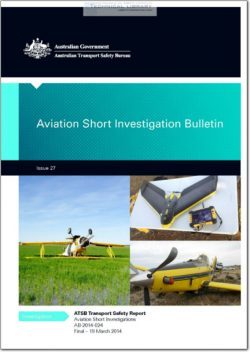ATSB-AB-2014-024

- Version
- 131 Downloads
- 3.12 MB File Size
- 1 File Count
- August 8, 2016 Create Date
- August 8, 2016 Last Updated
Aviation Short Investigation Bulletin - Issue 27

On 12 September 2013, at about 0930 Eastern Standard Time (EST),1 the pilot of an Ayres 82R
aircraft, registered VH-WBK (WBK), commenced aerial agricultural operations on a property about
37 km south-south-west of Horsham aerodrome, Victoria.
At about the same time, the operator of an unmanned aerial vehicle (UAV), Sensefly eBee 178
(Figure 1), arrived at the ‘lluka Echo’ (Echo) mine site to conduct an aerial photography survey of
the site. After having completed his pre-flight preparations and a risk assessment of the operation,
the operator heard an aircraft operating about 1-1.5 km away on a neighbouring property to the
north-east of the UAV launch site (Figure 2).
The UAV operator broadcast on the area frequency advising his intention to conduct unmanned
aerial photography operations over the Echo mine site for the next 4 hours, and addressed the ‘ag
aircraft operating north-east of Echo mine site’, but did not receive a response. He then asked the
mine manager to contact the farmer, who was loading the fertilizer into the hopper of WBK, to
advise him of the UAV operating in the area and request that he also notify the pilot of WBK.
The UAV operator then commenced operations on the western side of the site to increase
separation with WBK. The UAV conducted a series of parallel flights from north to south,
progressing from the western boundary of the area towards the east, at about 390 ft above ground
level (AGL).
After completing the first load of fertilizer, the pilot of WBK reported that the farmer informed him
there would be an ‘aircraft’ conducting aerial photography over the Echo mine site, near one of the
areas that he would be operating on. The pilot assumed this would be a fixed-wing aircraft
operating at or above 500 ft AGL, and intended to remain at or below 350 ft AGL to ensure
separation with the fixed-wing aircraft.
At about 1000, the UAV operator heard increasing noise from WBK and observed the aircraft
cross the site boundary from the north, conduct a 180° turn about 150 m north of the UAV, then
complete one full 360° turn before it departed again to the north. At the time, the UAV was on
approach to land, at about 380 ft AGL. The operator immediately put the UAV into a holding
pattern to maintain its current position. He estimated WBK was at about 100-150 ft AGL and came
within about 100 m horizontally of the UAV. He attempted to contact the pilot of WBK on the radio
but did not receive a response.
| File | Action |
|---|---|
| ATSB-AB-2014-024 Aviation Short Investigation Bulletin - Issue 27.pdf | Download |
Comment On This Post